Armored train Little-known veterans of the Great Patriotic
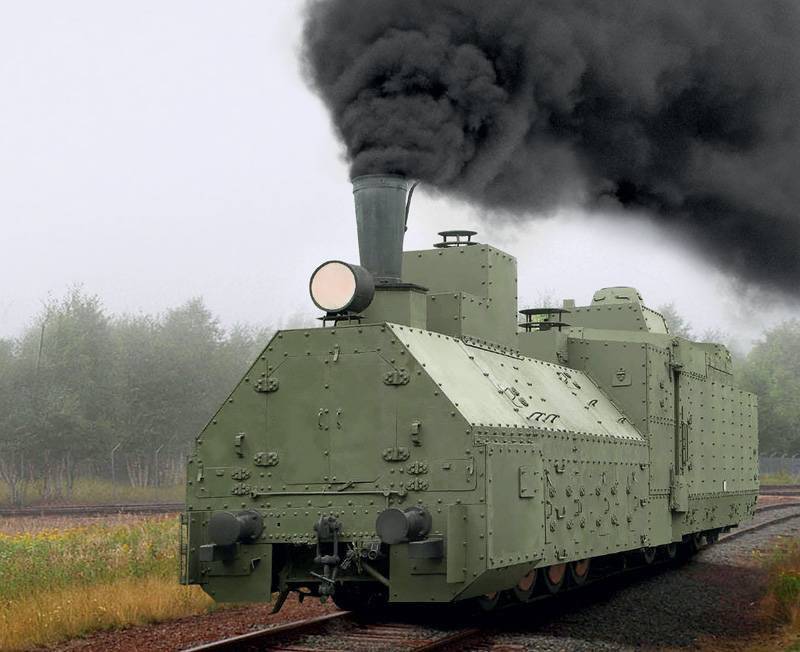
Matter issue
On 22 June 1941, there were over fifty armored trains in the Red Army, and in the NKVD troops there were two dozen. Their qualitative composition was far from uniform. There was even a certain number of armored trains in the troops, who had a chance to fight while still in Civil. Naturally, since then the material part of these "old men" has been solidly updated. This fact was one of the reasons for the fact that a considerable number of armored trains of the Great Patriotic War included O series locomotives story began at the end of the XIX century. The modern for the beginning of the war, the composition of the armored train was formed by the beginning of the 30-x: it consisted of one or two locomotives, several armored platforms, platforms with weapons for air defense and control platforms. Reservations for different armored trains differed, but most of the sheets of metal had a thickness from 10 to 20 millimeters. Tried to install and more solid armor. However, an increase in the mass of the armor site directly affected the ride quality of the entire train, and sometimes even required its change: either add another armored locomotive or remove the “extra” platform.
Let us consider in more detail the material part of armored trains. The basis of them - broneparovoz. In fact, this is the most common serial locomotive on which armor was installed in factory or even artisanal conditions. The locomotive of any modification could be used as an armored steam locomotive, but more often in the USSR locomotives of later modifications of the O series were adapted for these needs. The reason is simple: at that time it was the most popular type of such equipment. Reservation of locomotives, as already mentioned, was up to 20 millimeters thick. In the period between the world wars, it was considered sufficient to protect the crew and train assemblies only from rifle bullets. weapons and small-caliber guns. An armored locomotive was usually located in the middle of the train or close to it. Thanks to this, the armored train had less chance of losing the engine because of the explosives laid on the tracks. Sometimes weapons were installed on armored vehicles. Almost always it was Maxim machine guns.
Artillery armor sites were specially modified two- or four-axle railway platforms. An armored "box" was mounted on the reinforced platform, on which gun turrets were mounted. Most often on one armored platform there were two towers. According to the composition of the armor platform weapons were divided into two main groups: heavy and light. For heavy mounted guns in caliber up to 107 mm, as well as from five Maxim machine guns. The thickness of the armored hull of such sites often exceeded the "standard" 20 millimeters. However, despite solid defense and powerful weapons, heavy armor platforms by the end of the 30's were already outdated. At that time, the new light platform PL-37 was offered as the main platform with weapons for an armored train. With armor two centimeters thick, it had two towers armed with 76 mm 1902 / 30 model guns. In the embrasures of the case there were six Maxim machine guns. The total ammunition of weapons was 560 shells for cannons and nearly thirty thousand cartridges for machine guns. The armor was assembled from 20-mm steel plates. Platform PL-37 had an intercom system, steam heating and rather large boxes for various property, located under the floor of the fighting compartment.
The anti-aircraft armor sites in their design to some extent resembled artillery, with the difference that they had weapons for attacking aerial targets. The armament was the most varied: on four types of anti-aircraft platforms, quad Maxim machine guns, large-caliber DShK machine guns and 37-mm automatic guns were installed. By 1942, 76-mm guns were also installed on anti-aircraft platforms.
At the beginning and at the end of the composition were established so-called. control platforms. These were the most common railway platforms loaded with ballast. Sandbags or even spare rails with sleepers were used as the latter. Due to the presence of control platforms, the push action mines laid under the paths did not harm the armored train’s warhead. Mina damaged only the platform with ballast. The roads broken by a mine could be repaired by the forces of the crew of an armored train. Finally, armored trains had a so-called. the base. It consisted of a half or two dozen goods and passenger cars. The base included a staff car, a kitchen car, a workshop car, an ammunition car, etc. In the “traveling position” of an armored train, the base was transported as a whole, and when the train went into battle, the base was left in a safe place, for example, at its railway station in the rear.
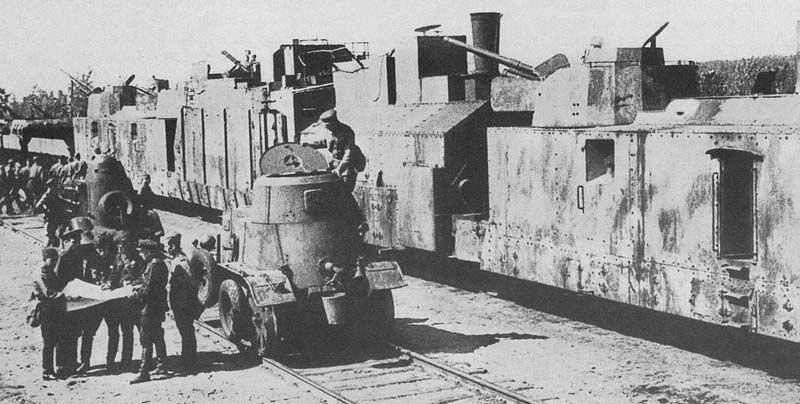
At the beginning of the Great Patriotic War the most massive domestic armored train was BP-35. It consisted of two artillery platforms PL-37 (shortly before that, they replaced the outdated PL-35) and one anti-aircraft SPU-BP with the quad Maxims. In general, it was a good armored train. However, the experience of a real war soon showed all its advantages and disadvantages. Guns and machine guns were quite good strike force, but the air defense and booking were insufficient. Only for the second half of the 41 year, four (!) New types of armored trains, artillery and anti-aircraft guns were created at once. All of them were produced in various quantities, and the anti-aircraft armored train of the 41 model was the “record holder” in this regard - more than a hundred of them were made.
However, the real crown of domestic construction of armored trains went to the troops only in the 1943 year, when the capabilities of the industry allowed it to focus on more promising technology, such as tanks. The BP-43 armored train became to some extent a “hybrid” of the classic armored train and tank. The fact is that the artillery platforms of the PL-43 were set up turrets from T-34 tanks, armed with X-NUMX-mm F-76 cannons and a twin DT machine gun. In addition to the tank turret on the PL-34, there were two DT machine guns in the embrasures. Ammunition of one armored platform was 43 shells and 168 cartridges. Thanks to the installation on the armored platform of the tank tower, the combat potential of the train increased. This happened because of a more effective gun, new sighting devices and the ability to fire in all directions. As a result, the BP-4500 armored train could successfully fight with most German tanks of that time. Two anti-aircraft defense anti-43 platforms were armed with two 4K automatic cannon of 61 caliber of millimeters or two DShK large-caliber machine guns. When creating armor sites for BP-37, several interesting know-how was applied. Thus, the PL-43 and the air defense-43 were made on the basis of two-axle platforms, thanks to which they were able to place one tank tower on a platform. Among other things, this increased the survival rate of the gun crews - with the defeat of one tower, the neighboring platform did not suffer much. In the case of the installation of two guns on the same armored platform, almost always one hit of a projectile of sufficient caliber failed both calculations. Also, instead of the usual booking in the form of a "box" the size of a standard car on new sites, only the necessary volume was protected, which allowed us to reduce the weight without loss of protection. Moreover, as a result, the protection did not deteriorate a bit - the new design made it possible to install thicker sheets of armor (in some places up to 4 mm).
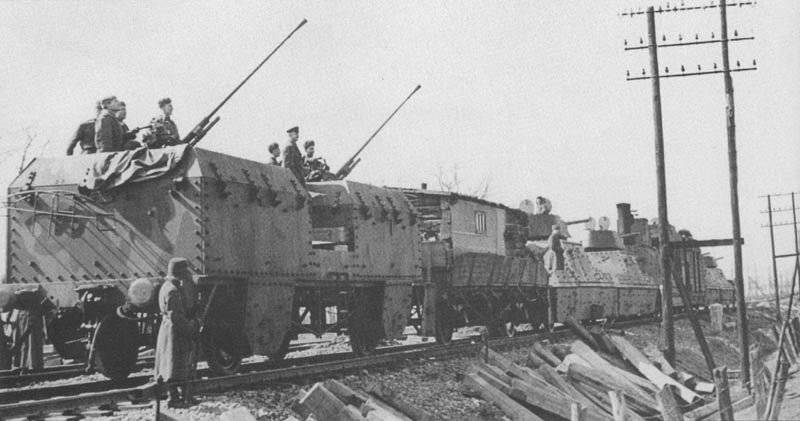
In battle
The main, and sometimes the only, task of armored trains throughout the war was to support units operating close to railway tracks. Also, sometimes armored trains helped to take the station or even to fight a counter battery. Sometimes armored trains also became a means of transporting troops, but such tasks were not set very often. Nevertheless, even such a "banal" work, as fire support units, clearly showed the effectiveness of armored trains. In October, the 41-th USSR Commissariat of Defense ordered the creation of an 32 division of two armored trains in each by the end of next year. The rear workers did not disappoint - for the allotted time, it was not 64 built, but 85 trains!
Crews of armored trains were also role models. During the war years, all armored trains in total destroyed nearly four hundred enemy tanks, about 350 guns, 840 machine guns, over seven hundred cars, 160 motorcycles, 115 aircraft and two enemy armored trains. And this is taking into account the fact that an armored train can operate only where there is a suitable railway track. However, the losses were also considerable. In the 41 year, the enemy managed to destroy the 21 our armored train. The following year, killed twice more armored trains - 42. At the same time, for the 1943, the Germans were able to get rid of only two armored trains, and since then, similar domestic equipment has not received fatal damage. For 1944-45 years, we have not lost a single armored train.
The main reasons for the great losses at the beginning of the war are the features of the battles of that time. Frequently, the railway men remained to cover the waste of the Red Army and were actually suicide bombers. In addition, the German tanks and aircraft in the first two years of the war were too great a force for the prewar armored trains to fight on an equal footing. Accordingly, when it became possible to build a sufficient number of tanks and strengthen the armament of armored trains, the losses of the latter were significantly reduced. And even the attachment of trains to the railway by this time ceased to carry an indirect threat to the rolling stock and crew.
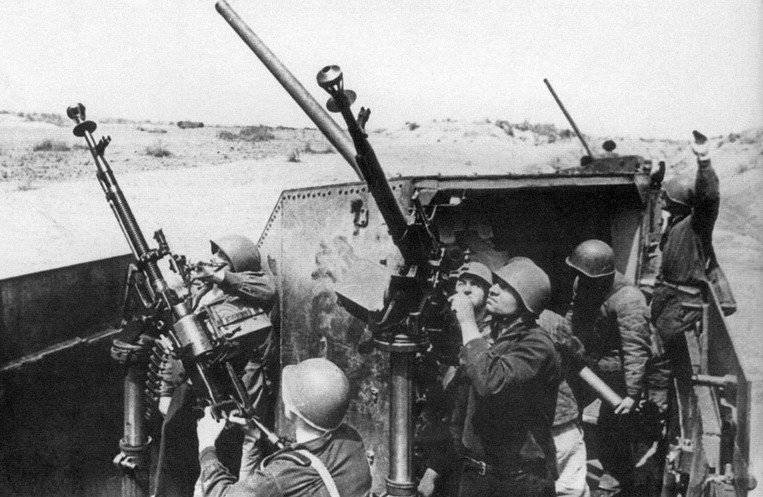
Victory and defeat
Throughout the Great Patriotic War, armored trains actively participated in battles and committed feats. Unfortunately, to list all of them you need to write a rather voluminous book, so we confine ourselves to only a few heroic episodes.
Ukraine, Zhulyany, August 1941. The Germans captured the station, which was a few cars with ammunition and equipment for aviation. Fearing a possible counterattack and the loss of a valuable trophy, the Germans made their way and blew up a small bridge leading to the station. At that time, not far from Zhulyan was the armored train "Litera A" (commander A. Tikhokhod), who was instructed to recapture the valuable cargo from the enemy. Under the cover of night, a detachment of Red Army men restored the paths dismantled by the Germans and the blasted bridge. At four o’clock in the morning on freshly laid rails, an armored train burst into the station and began firing at all targets that only came into view. The invaders suffered heavy losses, but there was no possibility of finally repulsing the station. Therefore, wagons with cargo for aviation were picked up to an armored train and taken away with them.
On November 4, the 41st, the Zheleznyakov armored train, or more officially, BP No. 5 of the Coast Defense of the Black Sea Main Base, left the gates of the Sevastopol Marine Plant fleet. Later, the Germans will come up with the nickname "Green Ghost", and not casual. Zheleznyakov was, to some extent, an impromptu armored train. But this did not worsen his fighting qualities a bit, because armored train No. 5 had five 100-mm guns, eight mortars, and a dozen machine guns. In addition, in addition to the main armored locomotive, the Zheleznyakov included an additional locomotive that significantly improved driving performance. Already on October Revolution Day, Zheleznyakov made his first “gift” to the Germans: he fired on the infantry’s location near the village of Duvanka and destroyed the artillery battery on the slope of the Belbek Valley. By the end of the 41st, the final appearance of the Zheleznyakov armored train was formed. One of the 100 mm guns was replaced with two automatic anti-aircraft guns, and half of the 82 mm mortars were removed to make room for three 120 mm guns. Finally, the train received three more machine guns. In addition to armament, BP No. 5 received a new appearance - the crew applied camouflage paint to all surfaces of the train. According to eyewitnesses, the armored train merged with the terrain even at a relatively short distance. This is probably why the Germans were not able to find Zheleznyakov until mid-forty-second. Rather, they made attempts to bombard the alleged position of the Soviet armored train and raised aircraft. Yes, only all attempts were in vain - the commanders of Zheleznyakov, Lieutenant Tchaikovsky, and then engineer-captain M. Kharchenko skillfully thought out their attacks, and the train managed to shoot back and go into cover much earlier than the first German shells fell on the train’s former position. For nearly one and a half hundred trips, the “Green Ghost”, as the Germans called it for elusiveness, destroyed about five to seven enemy tanks and armored cars, two and a half dozen machine gun nests and bunkers, half a dozen dugouts, three aircraft, one heavy artillery battery and up to one and a half thousand enemy soldiers and officers. In June 42, the Zheleznyakov even entered into battle with a column of German tanks and emerged victorious, destroying three armored vehicles.
The end of the celebrated armored train began on 26 June 1942 of the year. "Zheleznyakov" stood in the Trinity tunnel and was preparing for the next exit to the position. The German command from somewhere learned about its location and sent there more than fifty bombers. The raid was partly successful: one entrance to the tunnel was littered, and the collapsed structures inside it buried under one of the armored platforms of the train. However, the second site was removed from the remaining exit of the tunnel and began shelling enemy aircraft. The possibilities of damaged steam locomotives were only enough to pull the site back into the tunnel. The fighters did not wait for help. The second raid the next day led to the collapse of the second entrance. In August of the same year, the Germans set about clearing the tunnel through which their trains had to pass. Zheleznyakova armor sites were restored; The new armored train received the name "Eugen." The German “version” of the Soviet armored train could not be compared with the “Zheleznyakov” in performance, and in May the 44 of the Eugen was destroyed by the retreating Germans.
At the beginning of 42, the Murom and Gorky railroad workers, on their own initiative, assembled and transferred to the Red Army the same type armored trains Ilya Muromets and Kozma Minin, respectively. Both trains entered the 31 separate separate Gorky division. These trains can rightfully be called the direct ancestors of the BP-43 project trains, because tank towers were installed for the first time on Muromts and Minin. It should be noted, in contrast to the BP-43, on the Murom and Gorky trains armored platforms were equipped with two towers and had four axes. Also, the armored train of the 31 division had quite a significant thickness of armor for the beginning of the 42, in some places it reached 45 millimeters. Shortly after the start of operation, "Ilya Muromets" and "Kuzma Minin" were the first armored trains in the world that received rocket artillery in the form of launchers for M-13 projectiles. It is because of this that the division received special status.
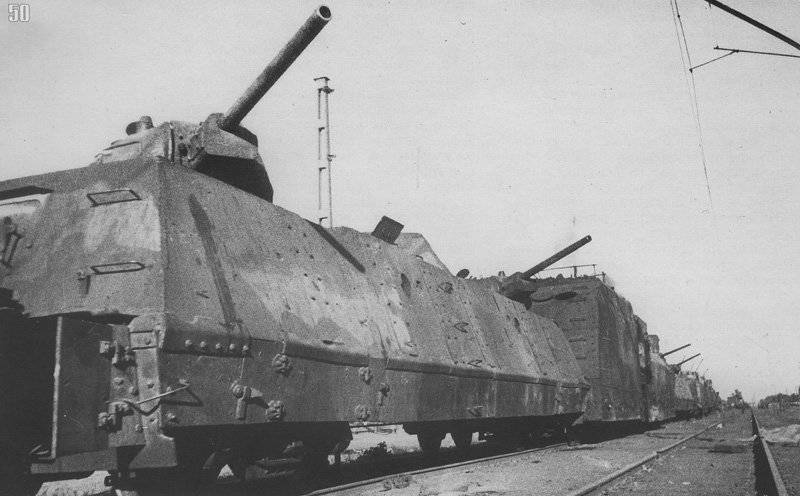
31-th separate special division successfully operated throughout the war, so there were a great many remarkable combat episodes during this time. Perhaps the most interesting of them occurred in May-June of the 44 year. There were difficult fights for the Ukrainian city of Kovel, and the 31 division was sent to help the advancing Red Army. In the last days of May, the Soviet positions came under three minutes of artillery fire. Intelligence roughly calculated the location of the enemy's battery, after which a plane was sent to the area in order to clarify the location of the enemy's guns. The flight did not give any result - there was nothing in the specified area. The next day, at the same time, the shelling was repeated. A few days at the same time, the Germans shot at our positions. An analysis of the terrain maps showed that the guns could be located only near the railway or even on it. The next day after this withdrawal, the scouts advanced in the proposed area in the morning. It was a few minutes to nine on the clock when in the distance there were clouds of smoke. So it is, our positions were bombarded by an armored train. In a short time, the headquarters of the 31 Division developed a plan for the upcoming duel. A place was found from which a Soviet armored train could successfully hit the German. 4 June at eight o'clock in the morning "Ilya of Murom" was already in this position and prepared to open fire. The Germans gave punctuality a second time: they shot from the same place every day at the same time. As a result, immediately after the first shot from the German armored train, Ilya Muromets also began to shoot. It should be noted that the artillery duel of armored trains in closed positions is an interesting, but rather complicated matter. The first volley to destroy the German train failed. The Germans managed to deploy the towers and tried to answer "Ilya Murometsu." But they did not know exactly where the Soviet railway workers were. Through 15-20 minutes after the start of the duel, “Muromets” hit the missiles. It was all over. Not a single shell hit the Soviet armored train, but the German was completely defeated. According to the evil (for the Germans) irony of fate, the lost train was called “Adolf Hitler”. Here is a historical fact with small notes of epic.
The 31 th separate Gorky Division reached Frankfurt an der Oder. Probably, “Ilya Muromets” and “Kuzma Minin” could have reached Berlin, only the ruined bridge across the Oder prevented them. The locomotives of both armored trains after the war were put on eternal parking. They became monuments to themselves and less fortunate brethren.
According to the results of military operations during the Great Patriotic War, two armored trains of the Red Army and three armored trains of the NKVD troops were awarded the Order of the Red Banner of Battle. Ten divisions received honorary titles for their services.
The end of the era of armored trains
Already by the end of World War II, it became clear that artillery had reached a level of development in which even seriously protected armored trains could be equated to lightly armored vehicles. In addition, the train tightly tied to the railway, which significantly reduces mobility. Aviation was not standing still, for whose means of destruction an armored train ceased to be a difficult goal. At the same time, the anti-aircraft armament of trains could no longer provide reliable protection against air attacks. It became clear that the time of armored trains passed. The development of new systems and the upgrading of existing armored trains continued at the very least until the middle of the 50-s, and in the 1958-m all similar equipment was removed from service because of hopeless obsolescence. But the experience of placing weapons on trains is not lost. At the end of the 80s, the so-called combat railway missile systems (BZHRK). In appearance, they are almost indistinguishable from civilians. At the same time, they transported strategic missiles and were able to launch them on any part of the route. But this is a new technique and a completely different story.
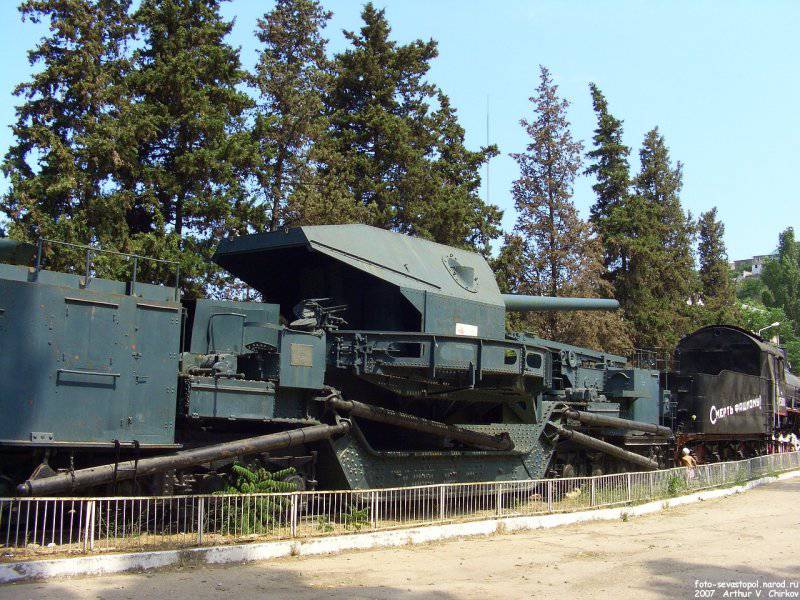
Information